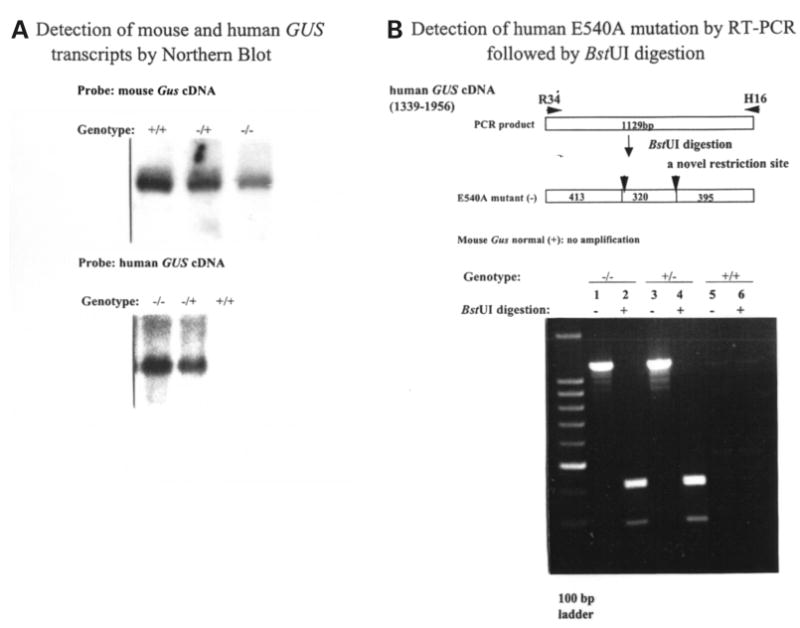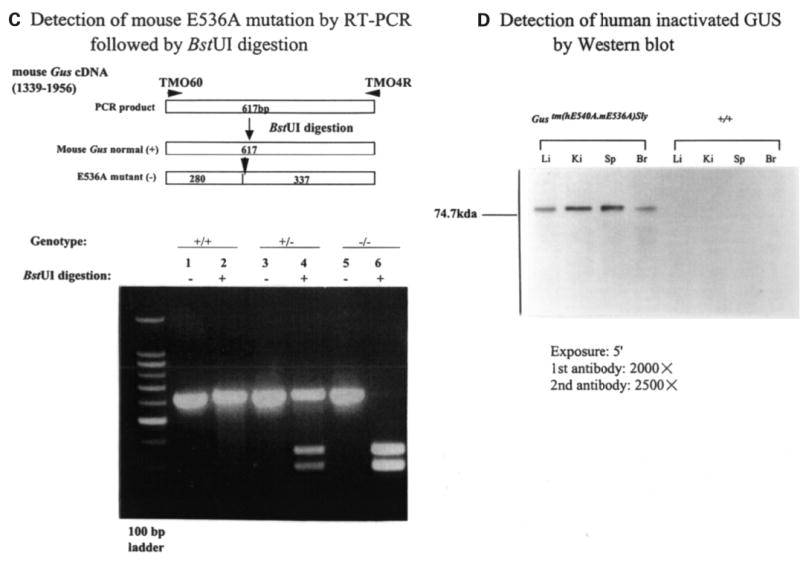Figure 7.


Expression of murine Gus (or human GUS) mRNA and GUS protein. (A) Northern blot analysis of murine Gus (upper panel) or human GUS (lower panel) mRNA from the livers of wild-type (+/+), heterozygote (+/−) and Gustm(hE540A·mE536A)Sly homozygote (−/−) mice. The 2.3 kb murine Gus mRNA transcript present in homozygous Gustm(hE536A·mE536A)Sly liver (upper panel, lane 3) was reduced in comparison to wild-type (+/+) and heterozygote (+/−) mice (upper panel, lanes 1 and 2). The murine probe does not cross hybridize with the human transcript under these conditions (data not shown). The human GUS mRNA was expressed only in the transgene containing Gustm(hE540A·mE536A)Sly homozygote and heterozygote tissues (lower panel, lanes 1 and 2). (B) BstUI analysis of human E540A mutation in hGUS transgene using RT–PCR. Fragments of 1129 bp were amplified from Gustm(hE540A·mE536A)Sly and heterozygote mice (lanes 1 and 3) using primers R34 and H16 (and visualized on a 2% agarose gel). No amplification from the wild-type mouse DNA (lanes 5 and 6) were seen. The 1129 bp fragments amplified from the mutant human transgene were cleaved into 413, 320 and 395 bp fragments by digestion (lanes 2 and 4). Note that the 413 and 395 bp fragments do not separate, so a doublet of these two and a single 320 bp band are seen. (C) BstUI analysis of mouse genomic DNA for the E536A mutation using RT–PCR. The 617 bp fragments were amplified using primers TMO60 and TMO4R from the homozygous Gustm(hE540A·mE536A)Sly (lanes 5 and 6), wild-type (lanes 1 and 2), and heterozygous Gustm(hE540A·mE536A)Sly/+ (lanes 3 and 4) mice, respectively. BstUI digestion cleaves the products from the mutant allele into 280 and 337 bp fragments (lanes 4 and 6). The 617 bp product of the normal allele is not cleaved by BstUI (lane 2). (D) Western blot for human GUS protein in extracts of tissues from Gustm(hE540A·mE536A)Sly and wild-type mice. The hGUS proteins from liver, kidney, spleen and brain tissues of the Gustm(hE540A·mE536A)Sly mouse were identified on western blot by anti-human GUS antibody (lanes 1–4). No band was observed in any tissue from the control wild-type mouse.
